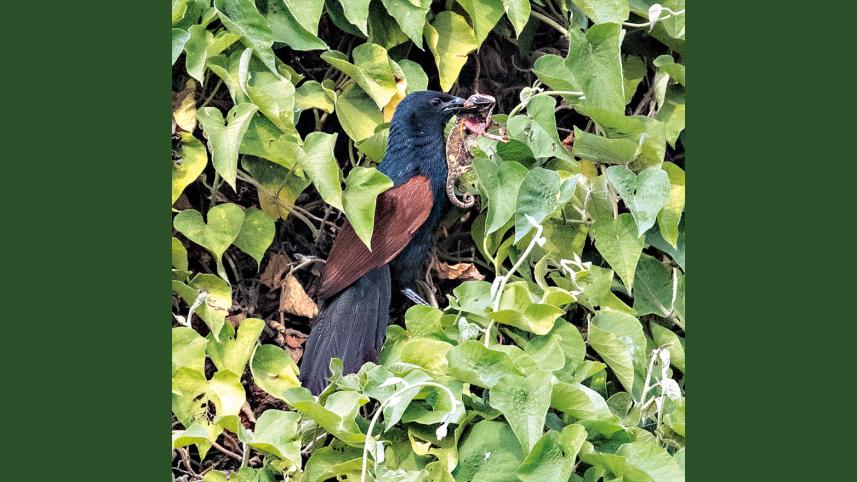Coucal

When my father passed away twelve years ago, he left behind a plantation where, for forty years, he had grown many types of plants. These included trees he had collected from various places in Bangladesh as well as species local to Sylhet area - including Aual, Rita, Bonak, Jhaoa etc. After his death I set about documenting his life's work in photographs. I photographed his plants for several months, but realized that to make it a complete document I should include creatures his plants supported. And so I started chasing butterflies, lizards, spiders, insects and monkeys with my camera. From there it was a natural progression to birds.
Most of my early bird photos were of common ones such as Doel, Tuntuni, Shalik and Bulbul, though I often caught tantalizing glimpses of unknown birds in the trees. One day I saw a new bird, slightly smaller than a crow, rust coloured on top with black head and tail and red eyes. It was hopping from leaf to leaf, branch to branch, of a large bush, close to the ground, sort of creeping through the foliage, picking out insects to eat. Then it landed on the grass and foraged from the ground. When it saw me it flew - rather weakly I thought - to a low-hanging branch and stayed out of sight. By that time I had taken a picture which I used later to identify it as a Greater Coucal.
Most birders in Bangladesh have seen it many times, but for others its unusual colour arouses curiosity. Coucals are closely related to cuckoos. There are 26 species of Coucals in the world. Their global range extends through Southern and Eastern Asia and parts of Africa. Bangladesh has two of these: Greater and Lesser Coucal (Boro Kubo and Bangla Kubo in Bangla.) At 32 cm., the Lesser Coucal is a full 10 cm. smaller than the Greater Coucal, and in my experience, much more elusive.
Our Coucals can be seen in light forests, grasslands, shrubs and bushes as well as tea plantations. They prefer to walk on the ground and forage rather than fly. They are likely to be out during early morning and twilight. During every trip to Sundarban that I have made, I have seen at least half a dozen Greater Coucals, close to the edge of the forest or foraging along the shore of the rivers.
My best Coucal experience was in Madagascar. I was in Lake Alarobia in the capital Antanarivo where hundreds of ducks and other birds can be seen. The lake is surrounded by a dense wall of tall trees. As I was walking around the lake on a trail, I saw a Malagasy Coucal land on one of these trees, high up. I immediately took a picture. Seeing me, it took off quickly.
It was only later when I looked at the picture that I realized that the bird had caught a chameleon. The poor chameleon's camouflage had failed when the Coucal came looking!
facebook.com/ikabirphotographs or follow ihtishamkabir on Instagram.



 For all latest news, follow The Daily Star's Google News channel.
For all latest news, follow The Daily Star's Google News channel.
Comments